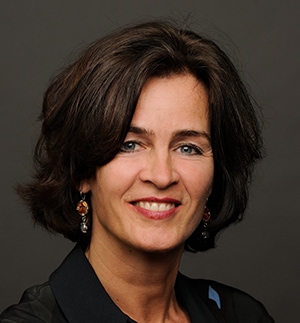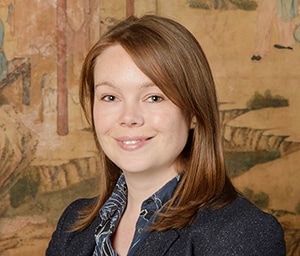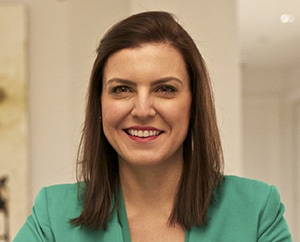While philanthropy has a long tradition among the ultrarich, private bankers say the inclination to give is stronger than ever—and vastly more complex.

Jestin, PHI: We lack data for the social sector; there’s no Bloomberg or Moody’s equivalent. |
Karin Jestin’s days at the office at Lombard Odier were different than the typical private banker’s. One challenging client demanded to know how she could improve palliative care in Switzerland. Another, terminally ill, had her heart set on endowing a scholarship for orthopedic surgeons, in memory of a past love. As medical education is state-funded in Switzerland, Jestin had to find a workaround through an “analogous” act of largesse that she doesn’t detail.
Jestin, former head of philanthropy at the venerable Swiss house, now consulting privately for Philanthropic & Humanitarian Initiatives, is one of a few confronting a big challenge for private banks: keeping abreast of their rich clients’ growing passion for personally designed worthy causes, and integrating that into staid banks geared to the nuts and bolts of asset management.
“You could call this the second golden age of philanthropy,” says Claire Costello, National Philanthropic Practice executive at U.S. Trust. The New York–based bank’s latest biennial survey of high-net-worth individuals in the US found that 76% saw charitable giving or volunteering as their best route to impacting society—only 1% favored political contributions. Nine out of 10 respondents engaged in philanthropic activity, and half volunteered their time. “People cite it as one of the highest freedoms of wealth,” Costello adds.
The US has been at the vanguard of high-net-worth charity since the age of the robber barons—at least the kind that emblazon surnames on buildings and foundations. US individual donations were nearly $390 billion in 2016, compared to $13 billion in the UK, and US foundation giving topped $58 billion, according to Katherine Lorenz, president of her own family foundation and a fellow at the National Center for Family Philanthropy. But the surge in highly personalized selflessness is global. “In the past year or so, philanthropists in the Netherlands have begun to talk about how and why they give,” says Marianne Verhaar-Strijbos, director of Private Wealth Management at ABN AMRO MeesPierson in Amsterdam. “They see that sharing their stories is more important than how wealthy they are.” Even Middle Eastern donors, whose attachment to anonymity was considered quasi-religious, are inching toward personalization, says Rachel Harrington, guru of giving at Coutts in London.

Verhaar-Strijbos, ABN AMRO: The toughest challenge is convincing advisers this is a serious trend. |
The drivers of this new golden age are diffuse. The rich are living longer, leaving fewer heirs and making their fortunes younger—all of which incentivize “giving while living” rather than traditional bequests. Modern barons like Bill Gates and Warren Buffett set highly visible examples. Millennial offspring are infecting their elders with a more holistic world view.
“The next generation doesn’t draw such a clear line between making money and using it for a good cause,” Verhaar-Strijbos says. Women’s share of manageable wealth has crept up to 50% in the US and Europe, adding the potential catalyst of the gender’s presumed generosity. “Women see wealth as means to articulate their values,” Costello says. “Men see it as goal unto itself.”
A few trends are clear. First, 21st-century philanthropists are more eclectic and entrepreneurial than the dutiful check-writers of the past. They want missions that matter to them. “We see a huge variety of causes that people care about—from helping with youth employment in London, to peace in the Middle East, to climate change,” says Harrington.
Second, private banks have a golden opportunity in this new age of largesse. U.S. Trust research shows that one-third of private-bank customers want a “goals-based, meaningful conversation” about philanthropy during their first meeting with an adviser, and 90% want it by the third, Costello says. “The train isn’t coming, it’s already in the station,” she adds.
Private banks risk blowing this chance, while competing outside consultants proliferate. A recent survey of 500-plus rich folk in the UK revealed both the hunger for good charitable advice—respondents working with an adviser reported giving 17 times more than peers who were winging it—and its scarcity. Advisers got an average satisfaction score of 5.9 out of 10. “High-net-worth individuals are not satisfied with the services they’re getting, but don’t know where else to go,” Lorenz concludes.
Fully 23 separate professional services are required for an effective “philanthropic journey,” from experts in the target field to tax accountants and estate planners, explains John Pepin, president of London-based Philanthropy Impact. No standard pipeline exists for philanthropy advisers, making hiring an ad hoc scramble. Donors lack established methods for evaluating the effectiveness of their giving, much less comparing rival nonprofits. “We lack data for the social sector,” Jestin notes. “There is no Bloomberg or Moody’s equivalent.”

Harrington, Coutts: Philanthropy options are more exciting than they used to be. |
The relationship bankers at the heart of wealth management are largely unsuited to address clients’ philanthropic impulses without substantial re-education, U.S. Trust’s Costello says. “If you’re trained as portfolio expert, you’re going to spew that knowledge,” she says. “But there’s a lot more to life than ROI.” Many line advisers are inclined to view the fuss about charity as a fad, Verhaar-Strijbos adds: “Our hardest challenge is convincing specialists within the bank that philanthropic advice for clients is not a hobby but a core activity,.”
Private bankers must also address their clients’ growing fascination with “impact investing,” which encompasses an expanding middle ground between deploying capital for disinterested profit and donating it as charity. The simplest type of impact investing is a “socially responsible” securities portfolio. But more complex forms—from lending to nonprofits on favorable terms, to seeding “social entrepreneurs” with venture capital that attaches fewer strings than a standard VC—are proliferating. “There used to be clear water between making money and giving it away,” Harrington says. “Now the options to make a difference are more exciting.”
Private banks that don’t adapt to the new philanthropy could lose valuable clients—if not now, then when the next generation inherits. Jestin recalls a call to Lombard Odier from a wealthy individual interested in switching banks because he wanted to “do something for his native country,” and had read about her efforts in the press. “Our research tells us that clients are much more likely to choose you if you engage them on meaningful goals,” Costello adds. “You retain through intimacy.”
Coutts, which launched its philanthropy advisory in 2004, offers a model for sowing the mission across the organization. Four full-time specialists in philanthropic strategy, including Harrington, are supported by six colleagues who administer family foundations, and about 15 financial advisers trained in the nascent science of impact investing. Coutts tries to reach heirs early. The youngest participant in a recent philanthropy workshop was nine years old. “The next generation is keen to think quite broadly and understand root causes,” Harrington says.

Lorenz, Mitchell Foundation: Giving away money is easy; making an impact is hard. |
One client not yet sold on any bank offering is Lorenz, who runs the Texas-based Cynthia and George Mitchell Foundation started by her grandfather. “We worry that most of the professional advisers don’t know much about philanthropy, if anything,” she says. “We use some outsourcing firms for legal stuff, but do the analysis ourselves.”
That’s a blunt statement of challenge and opportunity. What is your organization doing to meet it?


